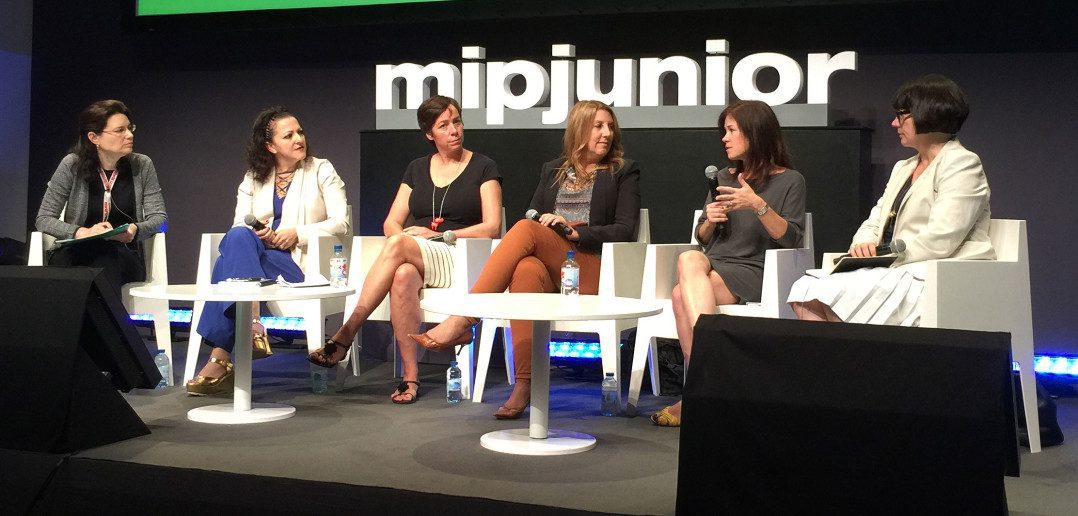The MIPJunior market is bustling this year, but what are buyers looking for? An ‘acquisition superpanel’ explored the trends this morning at the conference, with six key executives explaining what’s hot for them right now.
The panel included (l-r in photo): Adina Pitt, VP of content acquisitions and co-productions at Cartoon Network; Nicole Keeb, head of international coproductions and acquisitions at ZDF; Karen K. Miller, VP of worldwide programming strategy, acquisitions and co-productions at Disney Channels Worldwide; Tara Sorensen, head of kids’ programming at Amazon Studios; and Dierdre Brennan, head of children’s TV at Australian Broadcasting Corporation. It was moderated by Anna Carugati, group editorial director at World Screen.
The discussion started with a question about how children are watching TV shows and video. Brennan cited data showing that in Australia, 89% of children’s viewing is still on traditional TV sets.
Pitt said the important thing for broadcasters is to be present on all the platforms, regardless. « Children: they love to watch their favourite properties over and over again, » she said, noting that this trend is familiar in the linear television world. « It’s not that it’s different, it’s that there are so many platforms available, you have to be where they are, and have brand extensions available to your viewers in all those places. »
Sorensen said Amazon isn’t making a big distinction between the different devices that people watch its children’s shows on, but noted that her own children « don’t watch linear television any more ». Meanwhile, Keeb said ZDF in Germany still sees 90% of its children’s content airs through the television.
Miller talked about children’s tablet activities: playing games as well as watching their favourite shows. « They are using it every single way they can, » she said. ABC and ZDF are in the process of making a push into apps, while Cartoon Network launched its latest app this week. « So much of this, it’s not experimentation. Any investment a company sitting up here is going to make is based on ‘we think there’s a place in the market for this’, » she said.
What are the panel looking for? All agreed that new shows have to fit their brand. Miller said that « there’s very specific deliverables that we have for our audience: we have to make content, we have to buy content that sits side by side, and that also delivers on that brand. We have a huge responsibility to our audience, » she said. Pitt agreed: « We have very specific attributes: what we call the DNA of the brand… it has to exist in anything we make or acquire. It has to tick all those boxes… The brand is everything. »
This isn’t always the case: Keeb pointed out that ZDF carries such a wide range of programming, it is hard to define an overall brand that its children’s shows have to fit within. « We want to deliver high-quality, high-profile programming, » she said. « That would be the brand. »
Do buyers know if a show is boy or girl-skewing when it comes in? « A lot of people believe Disney Channel is for girls. It is. But it is equally for boys as well, » she said, noting that the separate Disney XD channel is more obviously branded for boys. Pitt agreed: Cartoon Network may be seen as a boys’ channel, but shows like Adventure Time do attract girls too. « I don’t think any of us would object to a female protagonist in a butt-kicking position, » she said. « There’s definitely room for both genders. But I do think you have to pick a side at some point, because you can’t be everything to everyone. »
Sorensen talked about Amazon’s perspective: she’s looking for a range of shows: from pre-school through to 6-12 year-olds. « Parents definitely play a role in how we bring programmes: we do pilot everything, we fully produce our first episode, put it online, and watch how people watch them, » she said. « Parents’ voices are present in the room. » And that means that for Amazon, it’s the parents’ views that govern some of its content choices: shows with violence (even of the cartoon variety) may not be right for it.
Brennan talked about ABC and its connection to parents, suggesting that the broadcaster had forgotten it, in favour of seeing adults and children as separate audiences. « We’re trying to bring that back… we’re looking at formats that could potentially be co-productions across the channels, » she said, suggesting that ABC is keen for shows that parents and children will watch together: « We need to speak to the parents in Australian families, or we will lose them both. »
Pitt said that while Cartoon Network targets kids, « you know at certain times you’re going to have a co-viewing experience, and sometimes those numbers can be shocking… everyone wants to be approved: you want your audience to love you, but you also want the parents to say ‘it’s okay to watch this’. » Brennan said that this is something she’s been thinking about a lot in her role at ABC: « It worries me a little bit that big reality franchise have become the family hits: I’m on a bit of a mission to bring storytelling back into the family mix. »
Pitt was asked about Cartoon Network’s global rebrand of Boomerang, its second flagship channel. « Really our aim is to build that brand, » she said. « We’re going to be targeting 4-7 year-olds. It’s not a pre-school channel. It’s not an educational channel. It is the home of Tom & Jerry, Snoopy, a lot of the Cartoon Network originals from a long time ago… It’s gender-neutral, it’s 50/50, so it’s different from Cartoon Network… But you will understand that they’re brother and sister. »
What’s missing from the market? « Money, » said Brennan, drawing a big laugh from the crowd. « We don’t have the luxury of time, so we have to act quickly, » said Pitt. « I want people to take more time before they come to us with their ideas though… We don’t have the luxury of time when making a decision, but please take more time before bringing ideas to us. »
Miller said what Disney wants to see more of is « really that unique visual style, but also that really strong creative voice. » And ZDF’s Keeb called for « big stories, something that really matters – there’s a lot of comedy on the market » before adding that she sees comedy has its place, but there’s room for other stories with « a big soul » too. « Personally, I’d like to see more real faces on screen, » added Brennan, wrapping up the session.




